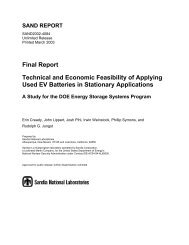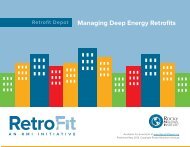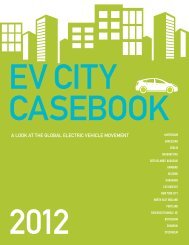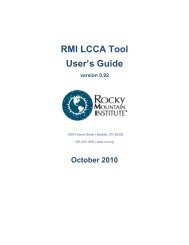Fleet Electrification Roadmap
Fleet Electrification Roadmap
Fleet Electrification Roadmap
- No tags were found...
Create successful ePaper yourself
Turn your PDF publications into a flip-book with our unique Google optimized e-Paper software.
68 part one: the case for fleets advantages of fleet operatorsfleet electrification roadmap 69FIGURE 1SChange in Energy Prices (2000–2010)54321Index: Jan. 2000=1020002001Source: DOE, EIA; EC Analysis200220032004prices. In the case of commercial and industrial enterprisesthat run fleets as part of core business functions,this volatility can cause significant budgeting and costmanagement challenges.This volatility is often difficult to plan for; it is theresult of complex dynamics in the upstream global oilmarket and downstream refining industry, as well asfederal, state, and local tax policy. Recent history providesa case in point. After steadily rising between 2003and 2007—and ultimately surging to record highs inmid-2008—crude oil and refined product prices crashedin late 2008 and early 2009. 42 Today, while crude oilprices have regained significant strength to averagebetween $75 and $85 per barrel, gasoline and dieselprices are somewhat below what might be expected.This is largely the result of weak domestic demand inthe United States. 43In cases where EVs or PHEVs would meet theirmission requirements, fleet operators may be willingto hedge against petroleum fuel price volatility thoughelectrification. One way to do this would be to packagethe high cost of batteries with the low cost of electricityin a service contract similar to cellular phone packagesoffered by telecommunications companies today.Instead of purchasing a monthly “minutes” package,a fleet operator could purchase a monthly “miles”42 DOE, EIA, Petroleum Navigator, available at http://www.eia.gov/dnav/pet/hist/LeafHandler.ashx?n=PET&s=RWTC&f=M.43 Moming Zhou, “Crude Oil Drops on Weak Demand, Rising GasolineInventories,” Bloomberg , September 28, 2010.2005200620082009Crude Oil WTIRetail Gasoline–US City AverageRetail Diesel–All TypesRetail Electricity–All Sectorspackage. The cost per mile could include the value of thebattery, charging equipment, and electricity.In the United States today, the cost of such a packagemight be very near to the cost of gasoline per mile—perhaps even slightly more. However, an operator thatlocked into such a contract would be able to confidentlyplan for fleet operational costs over time. In fact, forfleet applications that have a high degree of confidencein the number of miles traveled per vehicle per day, thismodel could provide near certainty in budgeting operationalcosts. In an era of highly volatile gasoline anddiesel prices, that is likely to be an extremely valuablebenefit of electrification.Infrastructure BundlingJust as the high capital cost of batteries can be offsetthrough vehicle leasing, there should be nothing to preventthe cost of infrastructure from being financed overtime. This is certainly true in the passenger vehicle market,where a number of providers have announced plansto provide access to home and/or other charging facilitiesfor a monthly fee. However, infrastructure financingcould have important ramifications for fleet operatorsthat may need to purchase a significant number of chargersto support multiple vehicles.One option for infrastructure financing may be toinclude it as part of energy efficient building retrofits. Anumber of market participants have emerged in recentyears offering to finance the upfront costs of improvingbuilding energy efficiency in exchange for a portion of the2010associated cost savings over time. When implementedsuccessfully, the result is a more efficient building thatgenerates lower heating, ventilation, and air-conditioningbills—all while guaranteeing a revenue stream tothe service provider. Efficiency improvements may alsoallow commercial facilities to qualify for higher environmentalcertifications in programs like the Leadership inEnergy and Environmental Design (LEED) program.The inclusion of vehicle charging units in buildingretrofits could be a low capital cost, low-risk opportunityfor commercial and industrial entities to supporttheir use of EVs and PHEVs. However, other possibilitiesexist for financing fleet infrastructure at commercial andindustrial locations. In particular, local utilities may seevehicle charging as an opportunity to sell more power,and therefore may develop business models aroundproviding fleet operators with access to chargers for amonthly fee.ConversionsFor some fleet operators that are able to hold onto vehiclesfor an extended period of time, drivetrain conversionsmay provide a relatively lower cost option for utilizingPHEV or EV technology. A conversion simply replacesthe existing ICE powertrain with a new EV or PHEVpowertrain; the rest of the vehicle is retained. Therefore,conversions are likely to be most appropriate for heavilydepreciated assets.PHEV or EV conversions could fit within the operationalnorm for some companies today. For example, incertain service applications, calendar lifespan of a typicalvehicle can be in excess of eight to 10 years. In instanceswhere these vehicles also log high miles—waste removaltrucks, for example—fleet operators today sometimes optfor a drivetrain replacement rather than incurring thecost of purchasing a new vehicle.A number of companies today are marketing PHEVor EV drivetrains as standalone products for both consumerand commercial conversions. While the consumermarket may have potential, the value that many driversplace on vehicle appearance and age may limit the size ofthe overall conversion market. However, in fleet applicationsthat derive utility from maximizing the operationallifespan of a vehicle, PHEV and EV powertrain conversionscould represent a significant cost savings. Themarginal cost of an electric drivetrain compared to anICE drivetrain is likely to be less than the marginal costof replacing a complete ICE vehicle with an electric drivevehicle. Yet the fuel savings-potential of GEV conversionis essentially the same as a new asset. <strong>Fleet</strong> operatorswho opt for conversions will have a smaller upfrontinvestment to pay back, but will benefit from the sameoperational cost savings as operators who purchase theirvehicles new.
















